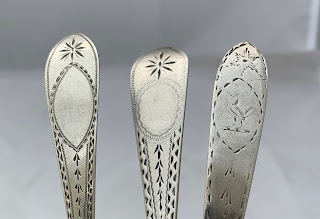Antique Irish Bright-Cut Sterling Silver
Bright-cut engraving hit England in about 1780 and was in fashion for about 30 years. It can be readily found on antique Georgian sterling silver spoons and sugar tongs of that time. Bright-cut decoration is when the pattern is faceted out of the silver so as to reflect light at different angles. Personally, bright-cut designs are one of our favourites, as there is such variety of patterns and they are very pretty to look at.
Ireland generally followed the English trends and Bright-cut was no exception. As they often did though, the Irish put their own national spin. There are four main patterns that you will find on Irish Bright-cut silver of the time; Star Pattern, Flower Pattern, Bow Pattern and Prince of Wales Plumes Pattern.
 |
| Examples of Irish Star Pattern on teaspoons |
Star Pattern
This is the most common and the most recognisable Irish pattern. It is seen in a number of forms, but the most readily found is the far right example shown.
 |
| Irish Star Pattern on a pair of sugar tongs by Benjamin Tait |
Flower Pattern
Flowers are a common design feature in all sorts of decorative arts. They were a reasonably common decoration in the Irish Bright-cut design. Normally just a single one is represented on each spoon/tong arm.
 |
| A more detailed flower on a pair of Irish sugar tongs |
 |
| The typical flower pattern, including a stem |
Bow Pattern
We've seen two main versions of the Bow represented. The first is a full almost three dimensional one, the second a single stylised version.
 |
| Two versions of the Bow Pattern on Sugar Tongs |
 |
| A worn example of a Bow Pattern on a teaspoon |
Prince of Wales Plumes Pattern
 |
| Prince of Wales Flume Pattern on a pair of Dublin Teaspoons |
This pattern was very popular in Limerick and on Limerick Silver, but it can also be found on Dublin made pieces. It has been suggested the emblem was related to Limerick's ruling family of Percy.
CHECK OUT SOME OF OUR IRISH SILVER FOR SALE: IRISH COLLECTION
Comments